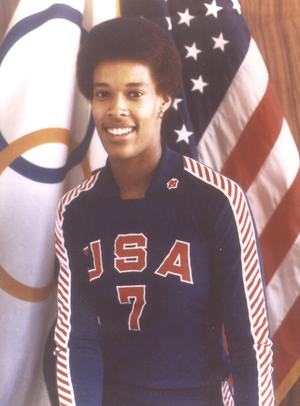Flo Hyman (Flora Jean Hyman)

Flo Hyman was the second of eight children. As a child, Hyman was abused by her parents and self-conscious about her rapid growth. She made it a habit to try to hide her size. She hunched when she sat and slouched when she walked. But her mother persuaded her to be proud of it and to use it to her advantage. Hyman’s parents were tall. Her father was 6’1″ (1.85 m) tall and her mother 5’11” (1.80 m), but Flo was to outgrow both of them. She stood six feet tall (1.83m) on her 12th birthday and her final adult height, which she reached by her 17th birthday, was just over 6′ 5″ (1.96 m). When she was 12, she began playing two-on-two tournaments on the beach, usually with her sister Suzanne as partner. By the time Flo was a senior in high school, she had developed a lethal spike. Flo Hyman graduated from Morningside High School in Inglewood, California and then attended El Camino College for one year before transferring to the University of Houston as that school’s first female scholarship athlete. She did not complete her final year, focusing her attention on her volleyball career. Hyman said she would graduate once her volleyball career was over and that “You can go to school when you’re 60. You’re only young once, and you can only do this once”. During her last year at Morningside High, Hyman was recruited by the University of Houston, which offered her a full athletic scholarship. She spent three years there, and led the Houston Cougars to two top-five national finishes.
Flo Hyman left Houston to play for the national team, based in Colorado. When Hyman joined, the squad was sorely in need of leadership. Operating without a coach, it had a host of talented players with no one at the helm to guide them. In 1975 the U.S. team floundered through qualifying rounds for the 1976 Olympic games and failed to make it. In 1977 the team finished fifth at the World Championships. Hyman and her teammates looked forward to qualifying for and playing in the 1980 Olympics, but their dreams were curtailed when the United States boycotted the Moscow games. Hyman played in the 1981 World Cup and the 1982 World Championship, when the US won the bronze medal. A speciality of Hyman was the “Flying Clutchman,” a fast, hard-impacting volleyball spike that travels at 110 mph (180 km/h). It was perfected under Dr. Gideon Ariel, a former 1960 and 1964 Olympic shot putter in Coto de Caza, California. At the 1984 Olympics, Hyman, by now both the tallest and oldest member of the team, led the US to the silver medal, beaten by China in the final. The United States had defeated them earlier in the tournament.
After the Olympics, Flo Hyman moved to Japan to play volleyball professionally where she joined the Daiei women’s squad in the Japan Volleyball League. She was so popular in Japan that she began a modeling and acting career there and was constantly in demand. She intended to return to the United States permanently in the summer of 1986, but never got the chance to do so. On January 24, 1986, Hyman collapsed while sitting on the sidelines after being substituted out in a game against Hitachi in Matsue City. She told her team to keep fighting, then moments later slid to the floor and died. She was pronounced dead at 9.36pm that evening. At first the cause of Hyman’s death was stated to be a heart attack. Not fully accepting this finding, her family requested that an autopsy be performed in Culver City, California. The autopsy, which was held on January 30, dismissed the possibility of a heart attack. It found that Hyman had a very healthy heart, and instead it was determined that she had suffered from undiagnosed Marfan syndrome, which had caused an aortic dissection she was also unaware of. Apart from her height, nearsightedness, very long arms and large hands, she showed few other physical symptoms.
The pathologist who performed the autopsy, Dr. Victor Rosen, said that Flo Hyman physically had been in superb condition except for a single fatal flaw—a dime-sized weak spot in her aorta. That small spot, less than an inch above her heart, had been there since her birth, and there the artery had burst, exploding inside her chest as she sat on the sideline in Matsue. There was a three-week-old blood clot around the tear, indicating that an earlier rip in the same spot had already begun to heal when the fatal second rupture occurred in her aorta. Doctors later discovered Hyman’s brother had Marfan’s Syndrome as well, and he underwent an open heart surgery afterwards. Experts believed Hyman was lucky to have survived as long as she did, playing a physically demanding sport such as volleyball. She was buried at Inglewood Park Cemetery, Inglewood, California on January 31, 1986. Over 500 people attended the funeral service.
Born
- July, 31, 1954
- USA
- Los Angeles, California
Died
- January, 24, 1986
- Matsue City, Japan
Cause of Death
- Marfan Syndrome
Cemetery
- Inglewood Park Cemetery
- Inglewood, California
- USA



